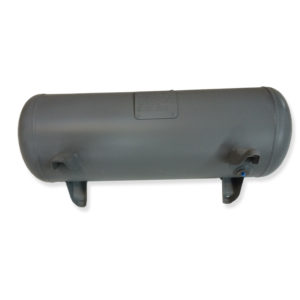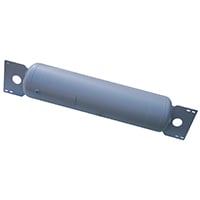What Is An Air Receiver Tank & What Does It Do?

An air receiver tank is a metal tank that stores compressed air until it is required. Air receiver tanks can vary in shape and in size, depending on the application. Air receiver tanks on service vehicles are typically 30 gallons, but still range from 6 to 50 gallons.
Some air compressors, such as reciprocating air compressors, require an air receiver tank to operate. But even air compressors that don’t need an air receiver tank can benefit from the installation of one.
What Does An Air Receiver Tank Do?
Air receiver tanks serve many important functions and roles within an air compressor system. An air receiver tank:
- Dampens pulsations from the discharge line of a reciprocating compressor, resulting in an essentially steady flow of air in the system.
- Serves as an air reservoir to take care of sudden or unusually heavy demands for air that’s in excess of the compressor’s designed capacity.
- Prevents the excessive cycling of a compressor.
- Knocks out solid dirt and particulate matter that may have passed through the compressor inlet filter or may be the result of compressor wear.
- Precipitates out contaminants and oil carry-over from the compressor oil that might get into the compressor discharge
- Helps cool the compressed air and precipitates out moisture that inevitably results from air compression
Pulsation Damping
During the compression of air in a reciprocating compressor, air is delivered in pulses through the discharge line. This pulsation is caused by the alternating suction and compression stroke of these types of compressors.
Adding an air receiver tank dampens these pulses and allows a smoother delivery of air to the tool or piece of equipment being used. Pulsation dampening also helps protect hoses and components from damage caused by pressure spikes.
Air Reservoir
Air receiver tanks provide a reservoir of compressed air. An air receiver tank is capable of storing compressed air to be used once the compressor has been turned off, and to offset sudden, heavy demands of air.
If sized appropriately, an air receiver tank may also allow the use of a smaller compressor in low duty-cycle applications requiring higher air flow than the compressor can continuously deliver. For example, a low CFM rotary screw air compressor that can’t quite power a 1” impact gun continuously may be able to do so with a small air receiver tank
Reduce Compressor Cycling

As mentioned above, the tank can store air and act as a buffer. This also allows the compressor to cycle on and off less frequently, which can reduce wear and tear and reduce energy consumption. Care must be taken to ensure that the compressor system is rated and able to run long enough to fill the size of tank chosen without overheating or causing accelerated wear.
Particulate and dirt removal
During everyday air compressor operation, dirt, wear particles, or other foreign matter may bypass the air filter or otherwise find their way into the compressed air stream. This debris in the air stream can then cause blockages, premature contamination of filters, and excessive wear on tools and equipment.
An air receiver tank helps remove some of these particulates and dirt from the compressed air system, as some of this material will naturally fall to the bottom of the air receiver tank before the air reaches the tool or equipment that’s in use.
Moisture Removal
Atmospheric air typically contains moisture that is drawn into the compressor during its intake cycle. The moisture holding ability of air naturally increases as the temperature and pressure of compressed air temperature rises. Hot, compressed air typically holds moisture in a vapor state, but that moisture will condense into liquid form as the air cools past its saturation point.
Air receiver tanks are typically uninsulated, which means that hot compressed air enters the receiver tank and immediately starts to cool by transferring heat to the environment through the walls of the tank.
Without an air receiver tank or aftercooler, this cooling happens in an airline and is commonly seen as liquid water coming out of the tools or equipment. When using an air receiver tank, much of this liquid is collects in the bottom of the tank, which can easily be drained at the end of each working day.

